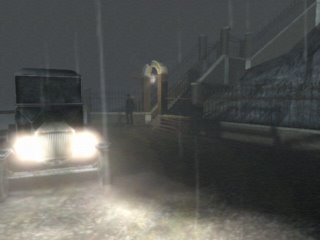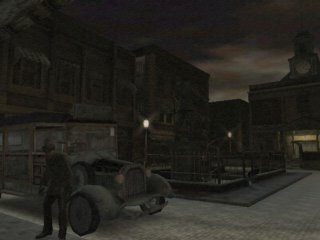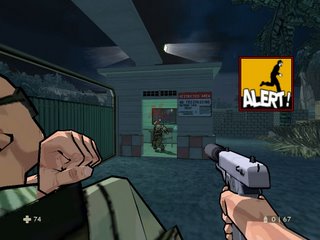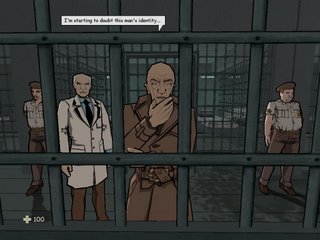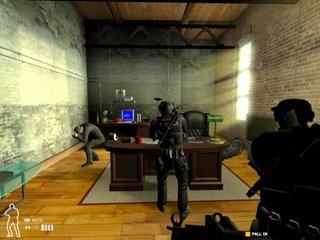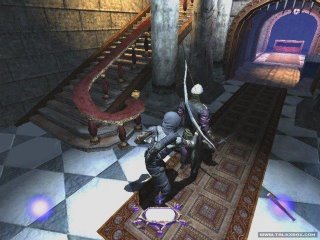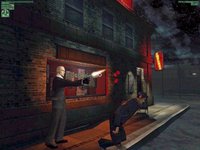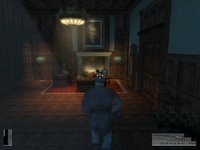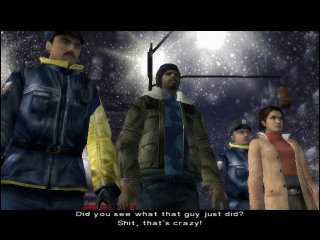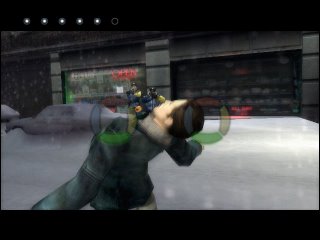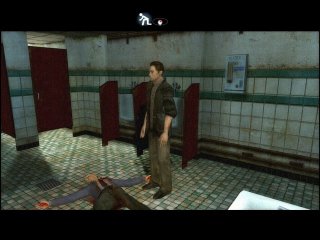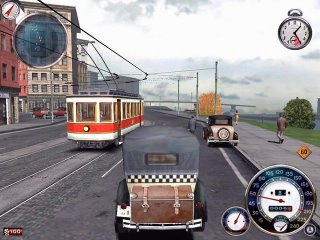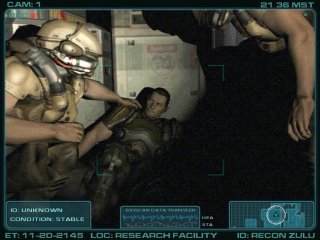Review: Call of Cthulhu
Website: http://www.callofcthulhu.com
Screenshots: http://www.3dgamers.com/screenshots/games/callofcthulhu/
Platform: PC CD-ROM, X-Box
Based on the fictional horror/thriller writings of H.P. Lovecraft (especially the short, "Shadow Over Innsmouth", "Call of Cthulhu" is a well done, first-person action/adventure interpretation of the mythos. From the menu, you're offered a few difficulties to start your game in. The more you uncover (such as journal entries), the more completed the game may become. Game completion is tracked in a Statistics menu, along with accuracy of shots, amount of kills and headshots, and more.
Your role begins as Detective Jack Walters. Released from the insane asylum after a period of amnesia, you're back in your niche when you recieve a call from somebody in the town of Innsmouth, asking for help investigating a local theft and a missing person. You arrive there via bus, and the first thing you may notice is the people populating Innsmouth are... different. It seems a plague has beset them - from their appearance and voice to the way they treat you, all creepy. For the first 1/4th of the game you'll be mostly exploring and finding clues. You won't get a weapon until the end of that first quarter, and even then it's a crowbar.
Despite that you're weaponless, you will find yourself in some hair-raising situations where you'll need to get out alive. One particular sequence has you escaping an Innsmouth hotel, opening doors and closing them, then bolting them - while your pursuers slowly but surely break down the doors you've left shut in your path. If you're a trigger-happy gamer with no patience, such sequences will likely upset you. Add to the fact that the game has no quick-save option - you can only save at a curious white symbol, which you'll find painted on walls. I honestly hadn't found the save system too bad, mostly because the game keeps you on your toes with it's adventure facet, with the pace and action picking up only until later.
Immersion is top-notch here, and one of the reasons for this is the lack of any HUD or onscreen indication of your health or ammo. This seems particularly foolish, but I adapted rather well to it. Your inventory screen can be referenced to see how much ammo you have left per bullet type, and any decline in health is indicated by shortness of breath, blurring of vision, blood splatters and declining hearing. You'll walk slower if you're injured, especially if you've broken a leg bone - of which you can hear cracking with each step. Use a medkit to patch up wounds or splint a broken bone and you're soon feeling better. Audio effects and voice acting is generally well done, if at times a little insincere. The music score is quite effective and meshes very well with the game - I enjoyed it very much. You may notice the graphics in Call of Cthulhu are dated, but don't let it dissuade you from giving the game a chance. The art direction is very well done here, evident in detailed textures and well-featured character models and detailed environments. Physics are rather non-existant, and characters die in animation sequences (then fade away) and not ragdoll effects - but it's really not an issue, the rest of the game makes up for such missing elements.
Interaction with the environment and characters saturates most of the gameplay. Whether toggling switches and solving fitting (and not too bizarre) puzzles, or keeping dialogue with characters to aid in your progression - there should be enough to do, to keep you engaged. You'll need to take a look at items or documents on desks, or even bookshelves, chests or drawers. Jack will mostly make comments on what you're interacting with, sometimes noting it's usefulness, or even it's uselessness. His dialogue may give you subtle clues - perhaps there is an area behind a warm wall, or a hole that requires a lever piece. Needing to actually be your character instead of some mindless tough-guy with big guns is quite a welcome break, and the action portions help breakup the adventure with some fun suspense. As far as environments go, I really have to credit the developers with giving us a fun variety. You may tire of the dark town of Innsmouth, but later in the game you should be quite thrilled to peruse the other locations. The detail and well constructed environments range from hostile sea cliffs to immaculate and shining temples, towns full of little landmarks, dark alleyways and shops, to intriguing worn-down houses, never knowing what may lie beyond it's doors. You'll really have to watch your step in the caverns and rocky areas. Some portions will crumble before you, or may feature semi-hidden traps which you can usually circumvent. It doesn't help that you can't run - some of the jumps would be easier. You can either walk (and it's slow), crouch, or sneak (which does help you get by unnoticed). One example where jumping a gap seemed quite impossible - I was in a burning bank, and had to clear a gap and land on half a staircase. I always missed it. When I checked some forums online, I'd realised there was a beam above my head I was hitting, and to avoid it - I had to move a little more to the left before jumping, as the beam was at a higher angle on that side. I then cleared the jump perfectly.
Whether protecting a coast guard ship and riding monolithic waves, exploring dark and otherworldy caverns keeping watch for monstrous beasts, or aiding the FBI in a shootout at a warehouse, or firing rounds from the back of speeding truck to escape a horde - there's never a dull moment. Some levels have simply awesome moments, of which I am tempted to give away but don't want to spoil you with. All I can reveal is you'll be facing some huge and interesting beasts. I'm not talking 8 foot demons like Doom's Baron of Hell - I mean much bigger, and all-the-more exciting.
There are a few key characters throughout the game you'll be meeting, and revisiting at some points. Innsmouth introduces you to a lady by the name of Rebecca, who isn't affected by the plague. A beautiful black-haired "dame", but her history is rather non-existant and we never really know what she's doing in Innsmouth or why she cares about your livelihood. Also in Innsmouth you'll find an accomplice of sorts, working undercover. You may want to visit him for help in further progression. Call of Cthulhu is not short of disturbing and gorey scenes involving semi-important characters either. This is beyond mere blood splatters and generic dismemberment - you'll be seeing guts and severed limbs or heads. Such scenes actually trigger Jack to go temporarily insane. This is a prominent feature of the game, and it is your obligation to keep your mind in check, by keeping yourself sane. Vision blurs and sways, Jack mutters out of fear, and hears chattery voices. The pinnacle of experiencing insanity for too long is that of suicide - although this is preventable. One way to aid this is to avoid looking at or investigating such gorey scenes, or even extremely unreal monsters. Inevitably, some experiences you just won't be able to avoid, and in this case you can just walk away for a minute and regain your composure, letting your heart-rate settle back down and your vision level out back to normal.
A first-person-shooter just wouldn't be as such without weapons, and once you acquire a decent set you have much better chances of survival. Weaponry ranges from a semi-auto pistol or revolver, double-barrel shotgun, tommy (machine) gun, rifle, and a powerful and rather cool weapon you'll recieve near the end of the game. Sometimes you will be able to man stationed weaponry, such as a cannon on the Coast Guard ship. Each weapon can be aimed - the ironsights brought up into center view - the game does not have a crosshair, and the ironsights perform well. Particularly fun is to take the knife, hit aim - and you'll be holding it with two hands, ready for a hard, downward stealth stab. Sometimes this is the only way to sneak your way through with a necessary kill and without firing a shot. Ammo is moderately located about and is usually in proper areas, not scattered about without reason - as is with med-kits. I did have one small issue with the weapons, and it involves controlling your viewpoint. Your weapon is not static or attached to a centerpoint of the player's viewpoint, and as such there is some swaying of the head while the weapon remains immobile. This does feel weird for those of us used to most first-person-shooters, but I soon had adapted to it and was no longer bothere.
An inventory screen is available as well , for collected items (such as important gems or useful objects) and journal entries. Your journal will feature automatic entries on recent experiences and thoughts, and collection of general evidence (such as notes and important writings), -- and occultic writings which actually aid in some areas of progression. Some discovered journal entries may help in opening locked safes or doors, but it isn't always obvious - and this is where a little online research or FAQ reading helps.
Interspersed throughout the game are cinematic cutscenes. Some are from the viewpoint of enemies or other characters, some are actually foretelling. Few are realtime interactive, such as flashbacks to your time in the asylum, or other horrifying memories. One particularly memorable scene (in first-person) is when Jack is laying on a table during interrogation in a dark room save for a ceiling lamp in your face, and an unknown man by your side. A doctor of sorts leans over with a pair of electrical clips, attempting to shock you into admittance. Such temporary breaks from actual gameplay tend to re-engage the player and piece together what my be going on beneath the surface.
Story progression is never fleeting and there's usually some new connection to reveal as you move on. You'll find the connection between the town of Innsmouth and a cult, ultimately finding it's deeper ties to the Cthulhu mythos and the journey you'll be partaking. Your actions don't affect any outcome or the world around you - Call of Cthulhu is pretty linear, which can be dissapointing. However, despite the linearity, the experience as a whole doesn't make lack of plot dynamism a big issue. Questions and confusion to whatever extent will ultimately arise in various spots, though a replay of the game may help piece together loose ends.
Outside of the story portion of the game, there isn't too much incentive to replay such a linear experience. You can unlock a few extra features such as concept art and character renders, or gain a Mythos ranking by completing the game in a certain amount of time completing it 100% (having found everything), but with Call of Cthulhu's few laborous situations, I'm just glad to be done with a memorable experience. It took me about 9.5 hours to complete the game in about a week. I should mention there are a few issues present, some of which I suspect came from the X-Box build of the game. An early chase/escape sequence was very hard for me to complete. The biggest factor was your timing, and you had to be quick and avoid any obstacles to your route, and pushing a few big bookshelves to progress to the next area. I had to drop my resolution and turn off anti-aliasing to pass this. Gameplay was much smoother, even though I had absolutely no performance issues at 1024 x 768. There is some kind of resolution/player-control synch issue and it's very frustrating that I had to sacrifice detail to remedy it. I experienced the same issue in a chaotic moment in "Indigo Prophecy" as well, where I also had to drop my screen resolution. Funnily enough, the graphics engine between them is quite similar.
A couple bugs have cropped up, one being the inability to push a set of 4 important levers, which all aided in completing the level. No matter what I tried, I could not attack the levers (you had to swat at them instead of 'use' them, because you weren't playing as Jack). The solution? I started the level over and now they worked fine. Another bug I recall is during a frenzied, quick cutscene that had ended, yet part of it still remained in effect, albeit part of the scene was frozen, and I was able to walk around the two characters featured in it. A reload of the saved game and the problem was gone. One more issue that wasn't too prevalent but occured when it was least welcome, was that I could not grab items such as a med-kit or ammo off a table. Jack just wouldn't "see" the item, thus picking it up - and instead would comment on the general area, such as "nothing useful here". By stepping back and looking at a different angle at the item, I was able to pick it up. Some items I just could not grab at all!
Call of Cthulhu was a very interesting and fun experience that I do not hesitate to recommend. If you're looking for chilling immersion, interactive environments and adventure elements, well-paced progression and tense action, $30 isn't too high a price to have it all in a well done adaption of Lovecraft's classic horror story.
Rating: 4 out of 5
Pros: Fascinating, immersive and thrilling gameplay and plot, artistic direction, awesome monolithic monster battles, good balance of adventure and action
Cons: A couple frustrating interaction and gameplay issues, no real incentive for replayability

